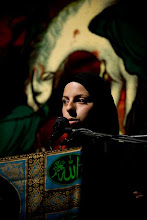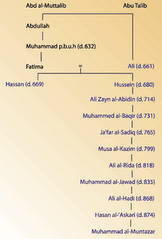 Falsafah Zanjir Zani
Falsafah Zanjir ZaniQ1: Why do Shiites beat their chests during Muharram? What is the reason?
A1: Beating chest is one of the important expressions of lamentation and a means of showing disgust and hatred to the oppressors. Not only it is not a mistake but it also plays an important role in reviving and continuing the goals of the Imam (a.s.).
Q2: It so happens that people beat their chests and their backs with chains and their bodies turn red and even start bleeding. Is it permissible?
A2: It is permissible and even preferable provided that it does not cause significant harm to the body.
Q3: Some men take off their clothes and become partially naked while beating theirs chests in front of women. Is it permissible?
A3: It is necessary for women to avoid looking. Of course, if men know that women would look at their bodies, it is not permissible for them (men) to take off their clothes.
Q4: Are beating chest and Zanjir Zani out of Riya (insincerity) permissible?
A4: They should avoid insincerity while performing rituals.
Q5: Some people are seen half-naked during Muharram while flagellating themselves in an extreme manner in front of non-Mahram individuals? Is this act permissible?
A5: Chest beating tradition in its customary and normal form does not have to be opposed, however, in the said situation women should avoid looking.
Blood Matam (Qama Zani)
Q1: I have a question about blood matam or what is known as Qama zani or Tatbir? What is your ruling about using blades, knives, swords and spilling blood during mourning rituals? Is it permissible?
A1: The philosophy of mourning during ‘Ashura, is to respect the symbols of Religion and remember the suffering of Imam Hussain (a), his companions, and his uprising to defend Islam and prevent the destruction of the religion by Bani Umayyad dynasty. These rites must be done in such a way that in addition to serving that purpose, it draws the attention of others to these lofty goals. Obviously, Qama Zani does not have such a role and the enemies of Ahlalbayt misuse it. So those actions which are not understandable for the enemies of Islam and causes misunderstanding and contempt for the religion must be avoided.

Mourning
Q: Is it legally preferable to wear black clothes when mourning for Imam Husain and other Infallible Imams (a.s.)?
A: Since it is considered respecting the signs (of Allah), it has legal preference. Moreover, prominent scholars such as late Ayatollah al-Uzma Broujardi used to wear black Qabaa (a long robe worn under Aba) during Ashura.
Q: Is wearing black clothes makrooh (undesirable) when lamenting and mourning over the martyrdom of the Infallibles?
A: Since wearing black clothes is a sign of expressing grief and lamentation, which is highly desirable, therefore praying in a black cloth is not makrooh.
Q: What is the fatwa about the flags which are used during Azadari (lamentation) ceremonies? Some of these flags have lines and drawings on them.
A: It is permissible to use them in Azadari.
Q: Is beating drum allowed during Azadari?
A: If drum is beaten in such a manner that it is suitable for gatherings of amusement and entertainment or is considered contempt and disrespect to the Infallible Imams, it is haram, or else, there would be no objection in it.
Q: What is your ruling on a group of mourners using musical instruments in a competing manner against another group?
A : The ruling about using musical instruments was explained above. Rivalry or competition however does not change the answer. Rather, if a competition is out of Reya (insincerity) and there is no intention of seeking nearness to God, and it causes unrest for others, it is not permissible.
Q: What is the philosophy behind the mourning for Imam Hussain (as)?
A: The philosophy of lamentation for Imam Hussain (as) is to revere the divine observances and to commemorate the Imam’s innocence and self-sacrifice as well as that of his companions, in their defence of Islam. If there had not been such an uprising, the Umayyad dynasty would have completely annihilated Islam. It is for this reason that to remember the tragedy of Ashura is cited in numerous narrations.
Q. Which Imam (as) or his companion was the first to practise any form of masochism such as hitting oneself with metal chains (zanjeer), or make a flag -referring to Al-‘Abbas’ flag- (‘alam) as a sign of the events of Karbala, or to produce and carry the coffin (taboot) among the believers during the commemoration in order to pay respect for Imam Hussain (as)?

A : These are all symbolic styles of mourning, and it is not necessary to have a certain decree issued by our Imams (as) for the way in which we mourn. However these ceremonies should be undertaken in a way whereby they keep alive the memory of Ashura, attract the attention of others and incorporate all the ritualistic aspects. They should not be conducted in such a way as to cause misunderstanding or blasphemy against Islam, the holy dignity of Imam Hussain (as) or his companions. We should avoid deeds, which are not understandable to the enemies of Islam. Commemorating ceremonies do not necessarily need to be ordered by the Immaculate Imams (as), as they are held today. The important message of practising (zanjeer) is that we are all Shi’ite, and are ready to devote ourselves in the path of Allah (swt) and for Imam Hussain’s (as) purpose
Zanjir-zani
Q1: Is Zanjir Zani permissible during Muharram? It should be noted that by the word Zanjir Zani I mean Zanjir (chain) only with no knives or cutting tools attached to it. (Many people in the Indian sub-continent ask this question while they mean the chain with knives. Unlike the sub-continent, the word Zanjir is used to give its literal meaning in Iran and other Persian countries).
A1: Zanjir-zani is permissible.
Lihat http://www.lankarani.org/eng/index.html
Nota Tambahan Taqlid Rahbar dan Ayatullah Fadhlallah:
Many of the male and female participants congregate together in public for ceremonial chest beating (matam) as a display of their devotion to Imam Husayn and in remembrance of his suffering. In some Shi'a societies, such as those in Bahrain, Pakistan, India, Afghanistan, Lebanon and Iraq, some male participants incorprate knives or razors swung upon chains into their matam. This practice is permissible by major Usooli Ayatollah such as Muhammad Shirazi, Lankarani and Sistani, however some major scholars such as Khameini have banned it in Iran temporarily, while others such as Fadlallah deem it permanently impermissible. In general however, the act is controversial. It is also considered by other Muslim groups a major sin











1 comment:
salam zainab,
saya amat menghargai entri-entri penjelasan sebegini. terima kasih.
wassalam.
Post a Comment